Kentucky Pesticide Safety Education Program

Questions?
Contact
Dr. Ric Bessin
Dept. of Entomology
University of Kentucky
859-257-7450
rbessin@email.uky.edu
The application method you choose depends on such factors as the nature and habits of the target pest, characteristics of the target site, and properties of the pesticide formulation. You also must consider the suitability of the application equipment, cost, and efficiency of alternative methods.
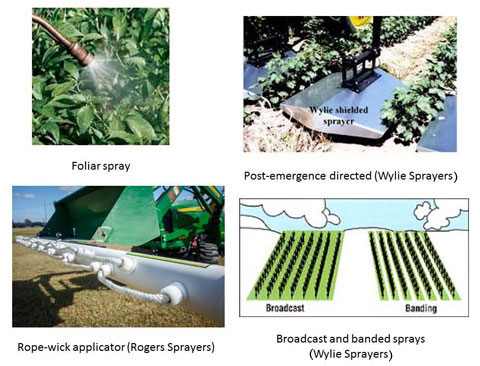
Here are some common pesticide application methods:
- Band -applied in parallel strips, such as between or over rows of crops.
- Broadcast-uniformly applied to an entire area or field.
- Directed-spray -targeted applications to minimize contact with non-target plants and animals.
- Foliar -directed to the leafy portions of a plant.
- Rope-wick or wiper treatment-released onto a device that is wiped onto weeds taller than the crop, or wiped selectively onto individual weeds in an ornamental planting bed.
- Soil -placed directly on or in the soil instead of on a growing plant.
- Soil incorporation-use tillage, rainfall, or irrigation equipment to mix pesticide into the soil.
- Soil injection-applied under pressure beneath the soil surface.
- Space treatment-applied in an enclosed area.
- Spot treatment -applied to small, distinct areas.
Safety Systems
Closed mixing and loading systems, enclosed application systems (e.g., enclosed cabs), and pesticide containment systems are excellent investments if you use large quantities of pesticides or products that are very hazardous to humans or to the environment.
Closed Mixing and Loading Systems

Closed pesticide mixing system (PMB Supply)
Closed mixing and loading systems are designed to prevent pesticides from contacting handlers or other persons during mixing and loading. The labels of pesticides with a high risk of causing human health effects may require the use of a closed mixing and loading system. There are two primary types. One uses mechanical systems to deliver the pesticide from the container to the equipment. The other uses water-soluble packaging.
Mechanical systems often consist of interconnected equipment that allows the safe removal of a pesticide concentrate from its original container by gravity or by suction. These systems also minimize exposure when rinsing empty containers and transferring the pesticide and rinsate to application equipment. Openings vary in shape and size so no single closed system works with all containers. Typically, pump-and drive units deliver the product. A meter allows accurate measuring from the minibulk tank to the sprayer. Usually, empty tanks are returned to the dealer for refilling. This eliminates the need to triple rinse or pressure rinse multiple small containers and reduces the number of used plastic containers.
Enclosed Cab
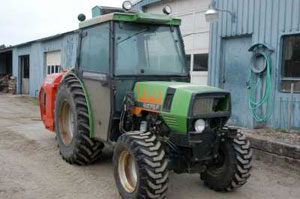
Spray tractor with enclosed cab (Univ. Vermont)
An enclosed cab (such as a tractor cab, cockpit, or truck/vehicle cab) surrounds the occupant(s) and may prevent pesticide exposure as long as the doors, hatches, and windows are closed during the application. Enclosed cabs are considered a supplement to personal protective equipment (PPE) -not a replacement for it. Applicators must wear all PPE specified on the label while working inside enclosed cabs. However, the labeling of some agricultural use pesticides may allow exceptions to the label specified PPE requirements for applicators in enclosed cabs. Check with the Kentucky Department of Agriculture for any other requirements regarding PPE and enclosed cabs. Remember, outside surfaces of the application equipment and cab are contaminated. Be sure to wear appropriate PPE when getting in and out of the cab or performing routine equipment maintenance.
Pesticide Containment Pad
If you often store, handle, mix and load pesticides, or clean equipment at the same location, you may have to install a pesticide containment pad. Check EPA and Kentucky state regulations to determine when a containment pad is required. These pads are designed to contain spills, leaks, overflows, and wastewater for reuse by the applicator or for disposal by a commercial waste management contractor. They make it easier to clean up spills and help to prevent environmental contamination.
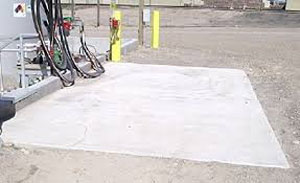
Impervious containment pad
Generally, the containment pad must be made of impermeable material. It should be concave or have curbs, berms, or walls high enough to hold the largest amount of spill, leak, or equipment wash water likely to occur at the site. It also must have a system to remove and recover spilled, leaked, or released material by either an automatic sump system or a manually operated pump. Smaller, portable pads and lightweight trays made of heavy-duty plastic may be used when mixing and loading at the application site.
Application Equipment
Hydraulic Sprayers
The application equipment or device must be able to apply the pesticide to the intended target at the proper rate. The label specifies the legal application rate and may suggest the appropriate equipment for use with the product.
Hydraulic sprayers range from large powered units with multiple-nozzle booms to small manual backpack or hand-held compressed-air sprayers. In all cases, pressure from either a pump or compressed gas or air is used to atomize the spray mix at the nozzle.
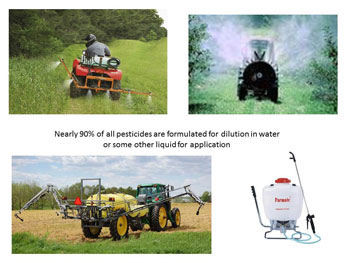
Manual sprayers are designed for spot treatments and for areas unsuitable for larger units. They are relatively inexpensive, simple to operate and maneuver, and easy to clean and store. Adjustable spray guns are often used with these units but some models have the option for a spray boom. The air-blast (or mist) sprayer uses both water and air as carriers. Spray droplets are formed by the nozzles and delivered to the target by an airstream. Air-blast sprayers are typically used for disease and insect control on fruit trees, vineyards, vegetables, and Christmas trees.
Sprayer Components
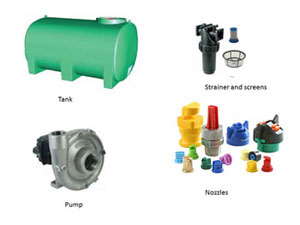
Tank
A tank is necessary to contain the spray mix. Choose one made of, or coated with, a material that does not corrode and that can be cleaned easily. Cleaning prevents accumulations of corrosion and dirt that clog screens and nozzles, increasing wear on the equipment. Large tanks require an opening in the bottom to aid in cleaning and draining. A large top opening is useful for filling, cleaning, and inspecting the tank. The opening must have a watertight cover to prevent spills. A tank agitation system/device is useful for most sprayable formulations, especially for wettable powders or dry flowables. Constant mixing of a pesticide and liquid carrier produces a uniform spray mixture (suspension) and results in an even application of the chemical.
Exposure to sunlight and corrosive chemicals can shorten the life of polyethylene tanks.
Three common signs of wear and potential tank failure are:
- Scratches are on the surface and can be seen and felt
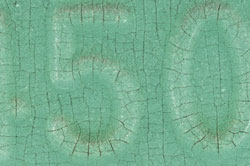
- Crazing is a network of fine lines or cracks that may look like a patchwork, but often cannot be seen with a visual inspection. Crazing can be seen when using one of the testing methods explained below. Crazing occurs within the tank wall and can be a sign of deterioration of the plastic, which may lead to cracks. Tanks that show signs of crazing will still hold liquids, but the integrity of the tank is questionable. For this reason, caution should be used when putting any hazardous substance in tanks that show crazing.(Photo: omafra.gov.ca)
- Cracks extend through the plastic wall and can be visually seen and felt. Cracks may run parallel or at right angles to each other.
Pump
A pump agitates the spray mixture and produces a steady flow to the nozzles. Pump parts must resist corrosion and abrasion, especially when wettable powders or similar formulations are used. Never operate a sprayer pump at speeds or pressures above those recommended by the manufacturer. You may damage the pump if it is operated dry or with a restricted flow at the inlet or outlet. Pumps depend on the spray liquid for lubrication and to prevent overheating.
Nozzles
The proper selection of a nozzle type and size is essential for proper pesticide application. The nozzle is a major factor in determining the amount of spray applied to an area, the uniformity of application, the coverage obtained on the target surface, and the amount of potential drift.
Nozzles break the liquid into droplets, form the spray pattern, and propel the droplets in the proper direction. Nozzles determine the amount of spray volume at a given operating pressure, travel speed, and spacing. Drift can be minimized by selecting nozzles that produce the largest droplet size while providing adequate coverage at the intended application rate and pressure.
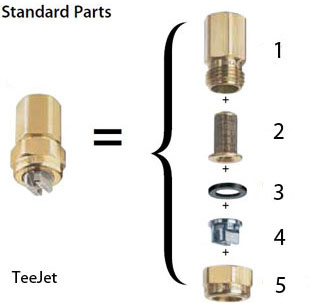
Nozzle parts:
1) The nozzle body holds the strainer and tip;
2) A strainer screen prevents a clogged nozzle. It is the best defense against nozzle plugging and pump wear. The screen can remove dirt and rust flakes from the spray liquid before it reaches the nozzle.
3) Tip gasket
4) The spray tip determines the flow rate and droplet pattern;
5) The cap holds the nozzle body and tip in place.
The Spray Tip
The spray tip determines the flow rate and droplet pattern.
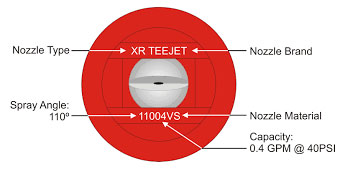
11004 nozzle
110 is the spray angle in degrees, 04 is the output - 0.4 gallons per minute at 40 psi (Source: TeeJet)
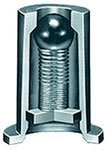
Equip nozzle tips with check valves to help prevent dripping when the pump is off. Be sure the spring-loaded ball valves are working properly.
Nozzle Spray Angle, Spacing, and Boom Height
Nozzle spray angle is formed by the edges of the spray pattern. Common angles are 65°, 80°, and 120°. A wide-angle nozzle (110°) produces a thinner sheet of water with smaller droplets than a narrow angle nozzle (65°) with the same delivery rate.

Nozzle spacing on the boom, spray angle, and boom height determine proper overlap of the spray. The drawing below shows the effect of nozzle spray angle on nozzle height, need for proper overlap, and spray coverage. Notice the height difference between the 110°, 80°, and 65° nozzles. Wide angle nozzles are placed closer to the target for proper overlap. A lower nozzle height reduces the risk of spray drift.

Flow meters and other devices measure the uniformity of nozzle flow rate from nozzles along a boom. They are very useful when calibrating sprayers with multiple nozzles.
Common Nozzle Spray Patterns
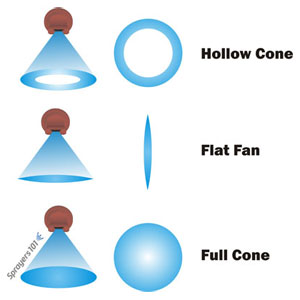
Three common nozzle spray patterns: hollow cone, full cone and flat fan.(sprayers101.com)
Hollow cone nozzles produce a fine spray pattern to completely cover leaf surfaces. Full cone nozzles produce large, evenly distributed droplets at high flow rates. These two cone nozzles are best suited to apply fungicides and insecticides. Flat fan nozzles form narrow, oval patterns with tapered ends. They are spaced along a boom and overlap by 30% to 50 % for even broadcast spray distribution to the soil surface or plant canopy.
Nozzle Maintenance
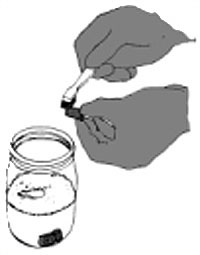 Nozzles are available in various materials: brass, aluminum, plastic, stainless steel, hardened stainless steel, and ceramic. Select the material best suited for the pesticide formulation being used. Never use brass or aluminum tips to apply abrasive materials (such as wettable powders and dry flowables) because they wear too fast. This wear increases the opening size of the nozzle, which increases its output. Reduce wear by using nozzle tips made of a hard, wear-resistant material: plastic, hardened stainless steel, or ceramics.
Nozzles are available in various materials: brass, aluminum, plastic, stainless steel, hardened stainless steel, and ceramic. Select the material best suited for the pesticide formulation being used. Never use brass or aluminum tips to apply abrasive materials (such as wettable powders and dry flowables) because they wear too fast. This wear increases the opening size of the nozzle, which increases its output. Reduce wear by using nozzle tips made of a hard, wear-resistant material: plastic, hardened stainless steel, or ceramics.
Be sure you have the correct screen size for each nozzle.
Clean nozzle tips with a soft brush, not wire or a knife tip.
Sprayer Cleanup
Clean your equipment thoroughly after each use or when changing chemicals. Pesticide residues can corrode metal, plug hoses, or damage pumps and valves unless removed immediately after use. Sometimes residues react with pesticides used later, reducing the effectiveness of the pesticides or causing crop damage. Some pesticide labels provide specific information on cleaning spray equipment; consult the label for guidelines. Do not clean spray equipment in areas where rinse water will contaminate water supplies, streams, or injure susceptible plants.

Mixing, loading, and application equipment should be cleaned and rinsed
as soon as you finish a pesticide application (USDA)
Pay special attention to areas that can be missed or are difficult to clean:
- Spray surfaces or components where buildup of dried pesticides might occur
- Sprayer sumps and pumps
- Inside the top of the spray tank and around baffles
- Irregular surfaces inside tanks caused by baffles
- Plumbing fixtures, agitation units, etc.
- Collection points where the hoses connect to the nozzle fittings in dry boom sprayers.
Special tank-cleaning nozzles are available to clean the interior walls of spray tanks. For all application scenarios, make sure the entire spray system is cleaned, not just the tank. This is especially true for commercial row-crop boom sprayers. Besides the spray tank, problem spots for pesticide contamination include the inductor; plumbing, which includes valves and hoses; filters and screens; boom segments; nozzle bodies; and nozzles and screens.
When possible, thoroughly rinse equipment with a strong water-detergent solution (8 to 16 ounces of detergent in 30 to 40 gallons of water). Allow the water-detergent solution to circulate through the system for several minutes. Remove the nozzles and screens, then flush the sprayer system twice with clean water. Some pesticide labels may require triple rinsing to rid the spray system of any possible pesticide contamination. Regardless of how the spray system is cleaned, make sure all visible deposits are removed.
Sloppy cleanup practices are one of the main causes of equipment failure or malfunction. Pesticides allowed to dry in the application equipment tend to clump and stick and cannot be easily removed. These deposits may eventually dissolve into the spray solution. Thus, improper cleanout may lead to contamination of tank mixes and damage to susceptible crops. Several commercial compounds will aid in tank cleaning. These can neutralize and remove pesticide residues, remove mineral deposits and rust, and leave a protective film on tank walls to help prevent corrosion.
Storing Your Sprayer
When preparing to store your sprayer, add 1 to 5 gallons of lightweight oil (depending on the size of the tank) before the final flushing. As water is pumped from the sprayer, the oil leaves a protective coating on the inside of the tank, pump, and plumbing. To prevent corrosion, remove nozzle tips and screens and store them in a can of light oil, such as diesel fuel or kerosene. In addition, add a small amount of oil and rotate the pump four or five revolutions by hand to coat interior surfaces completely.
It may be necessary to winterize the spray system to prevent damage from freezing temperatures. Be sure to either drain all water from the spray system or replace the water in the pump and other critical parts with an antifreeze material (RV antifreeze is commonly used). After thoroughly cleaning and draining the equipment, store it in a dry, clean building. Replace worn-out, deteriorated, or broken parts. If you store the sprayer outside, remove the hoses, wipe them clean of oil, and store them inside where they will not become damaged. When using trailer sprayers, you may want to put blocks under the frame or axle to reduce tire pressure during storage.
As with any pesticide-related procedure, remove contaminated clothes and take a shower immediately after cleaning equipment. Waiting until the end of the day to clean up may allow additional absorption of the pesticide through the skin.
Granular Applicators
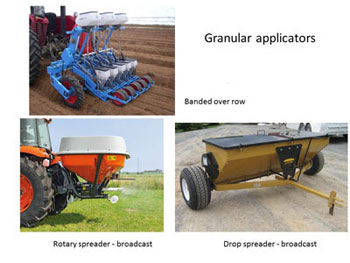
Granular applicators are available for either band or broadcast applications. They may be operated as separate units but often are attached to other equipment, such as planters or cultivating equipment, to combine two or more operations. Granular applicators usually operate by gravity feed and have an adjustable opening to regulate the flow.
Band applicators use hoses or tubes with deflectors on the bottom to drop the pesticide along a row. Broadcast applicators use a system of tubes and deflectors or a spinner to spread the granules. The application rate is affected by ground speed; granule size, shape, and density; field terrain; and even relative humidity and air temperature. Calibrate each unit of a multiple band applicator with the specific material to be applied to ensure accurate application.
Rotary and drop spreaders are two common types of granular applicators. Rotary spreaders distribute granules to the front and sides of the spreader, usually by means of a spinning disk or fan. In a drop spreader, an adjustable sliding gate opens holes in the bottom of the hopper. Granules flow out of the hopper by gravity feed. Drop spreaders are superior to rotary spreaders when more precise placement of the pesticide is desired.
Additional types of application equipment include:
- Bait dispensers to control rodents, insects, and predators.
- Foggers for indoor pest control and for some outdoor insect control.
- Chemigation systems for greenhouses and field crops.
[return]
1)The nozzle ___ determines the flow rate and droplet pattern.
2) Drift can be minimized by selecting a nozzle that produce the smallest possible droplet size.3) Applicators driving sprayers with enclosed cabs are exempt from wearing any personal protective equipment.
4) The strainer screen in a nozzle assembly ____________.
- increases spray pressure
- stops dripping during turnaround
- eliminates spray drift
- keeps the nozzle tip from clogging
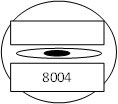
5) The spray angle and flow rate of this nozzle is _____ degrees and ______ gallons per minute.
6) If a nozzle with a 65° spray angle is changed to one with a 110° spray angle, the boom must be _______ to keep the same coverage pattern.
7) Hollow cone and full cone spray nozzles are best suited to apply pesticides evenly to the soil surface.
8) Strainer screens ARE NOT needed to catch product particles when applying only _____ formulations.
9) Which nozzle material is the best choice when applying mostly WP, DF, or WDG formulations?
10) Clean a clogged nozzle tip with a _________.
11) A check valve will help to ___________.
- keep the nozzle flow steady if the pressure drops
- reduce drift
- calibrate the nozzle
- prevent dripping when the pump is off
12) Flushing spray equipment with water is an effective way to remove residues of growth regulator herbicides.
13) Switching between granular products with smaller OR larger or lighter or heavier granules requires adjusting the flow rate of a rotary spreader.
14) Which spreader will give a more even application of a mix of different sized or weight granules?
15) Applicators driving sprayers with enclosed cabs are exempt from wearing any personal protective equipment.
16) In the ounce calibration method, 1 ounce of nozzle output equals ____ gallon(s) of spray per acre.
17) Calibration of a boom sprayer requires determining the sprayer output over an area and ___.
18) The measured distance to travel in the ounce calibration method depends on the _______.
19) Flow rate of granular formulations through application devices _______ as temperature and humidity rise.
20) All granular pesticide formulations flow at the same rate regardless of size, weight, shape, and texture.
21) The minimum distance to allow between a pesticide mixing and loading site and a well, lake, stream, or river is _____ feet.
22) Which of one the following statements is TRUE?
- Back-siphoning cannot occur if the end of the fill hose stays below the contents of the tank.
- Back-siphoning can occur if there is a sudden increase in water pressure while the tank fills.
- Back-siphoning cannot occur if the end of the fill hose stays above the contents of the tank.
23) Vapor drift is the uncontrolled movement of spray droplets away from the target site.
24) Cutting a droplet in half results in _____ times the number of droplets with the same total volume.

25) A network of fine lines or cracks on polyethylene spray tanks indicates _____________.
- a strong tank agitator
- residues of spreader stickers
- cracking due to excessive sprayer pressure
- crazing due to sunlight and corrosive chemicals
26) Pesticide residues on and in spray equipment are easier to remove if they are allowed to dry first.
27) Any pesticides in rinse water from cleaning spray equipment are so dilute that they will not contaminate water supplies, streams, or injure susceptible plants.
28) When cleaning spray equipment, make sure the entire system is cleaned, not just the tank.
29) Sloppy cleanup practices are almost never one of the main causes of equipment failure or malfunction.
30) When preparing to store your sprayer, it is best to ___________________.
- add 1 to 5 gallons of a light weight oil before the final flushing
- leave some of the last spray mixture used in the system
- leave the system completely dry
31) Spray droplets evaporate fastest when ___________________.
- both temperature and humidity are low
- both temperature and humidity are high
- temperature is high and humidity is low
- temperature is low and humidity is high
32) Vapor drift is most likely to occur when the temperature is above ___ degrees F.
33) Vapor drift can occur only during a pesticide application.
34) A temperature inversion occurs when the air close to the ground is cooler than the air above it.
35) Phytotoxicity due to pesticide carryover can occur if _______________.
- lower than label rates are used
- environmental factors reduce normal breakdown
- a sensitive rotational crop is planted before the recommended waiting interval
website designed by P.M. Dillon copyright © 2016 University of Kentucky Department of Entomology
University of Kentucky College of Agriculture |
S-225 Agricultural Science Center North, Lexington, KY 40546-0091 | 859.257.7450
An Equal Opportunity University |
Last modified
11/30/2018
